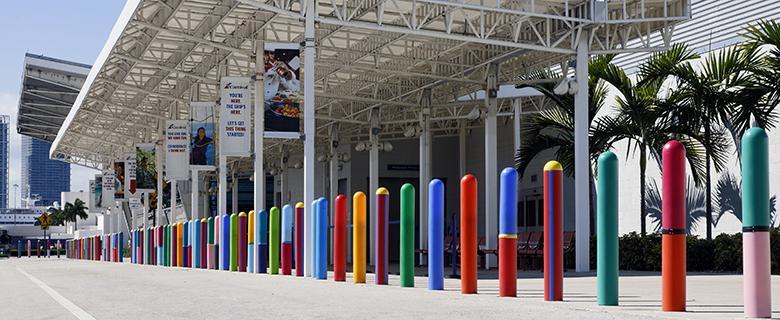The historic designation of the property
Q: Is the property designated historic? And if so, what makes it historic?
A: The Coconut Grove Playhouse was designated historic by the City of Miami’s Historic and Environmental Preservation Board in 2005 via Resolution HEPB-2005-60. It is important to note that the designation report outlines the front façade as the feature with the extant architectural significance. The designation report is available at: http://www.historicpreservationmiami.com/pdfs/Coconut%20Grove%20Playhouse%20-%20FINAL%20-%2005-27-05.pdf
The history of the site and the new theater
Q: How will the history of the site be preserved and/or incorporated into the new theater?
A: The entire historic front building, the iconic view that has been the Southern threshold to the Coconut Grove commercial area on Main Highway, will be restored, including the reconstruction of the 1927 Kiehnel and Elliott design of the parapet at the corner entry, the restoration of the street level storefronts along Main Highway and Charles Avenue, and the return of the building’s original sienna color. The remaining original Kiehnel and Elliott elements in the auditorium, which include the solomonic columns, fountains, the proscenium arch, decorative grates and cornice will be saved and incorporated into the design of the new theater.
The façade of the new theater
Q: Why doesn’t the façade of the new theater look more historic?
A: Historic preservation principles encourage the clear distinction between the historic portion of a project and new construction. The proposed façade for the new theater building takes its cue from the coral rock walls, wood trellises, vines, foliage and the lush tree canopies that are distinctive features of Coconut Grove. The naturalistic and low-profile design of the exterior of new theater serves as a non-competing backdrop for the historic building and takes its inspiratin from the mid-century modern architecture that helped define the unique, sub-tropical character of Coconut Grove. The buildings will tell a story with their materials and style; that story celebrates and honors the past while also articulating the excitement of the future.
The status of the application for the National Register of Historic Places
Q: What is the status of the application for placing the Coconut Grove Playhouse on the National Register of Historic Places?
A: On October 19, 2018, the National Park Service accepted the nomination for the Coconut Grove Playhouse and listed the property in the National Register of Historic Places. In announcing the listing, the State of Florida Division of Historical Resources stated, “the property is listed in the Register under Criterion A: Entertainment/Recreation, period of significance 1955-1970, at the local level of significance for its role as a live theater in Miami under George Engle and Zev Buffman; and under Criterion C: Architecture, period of significance 1927, at the local level, for its Mediterranean Revival exterior.” (emphasis added) Miami-Dade County supports the State’s initiative to place the Coconut Grove Playhouse on the National Register of Historic Places. The County, through its Office of Historic Preservation and its design team’s historic preservation architect Jorge Hernandez, provided constructive suggestions after reviewing the State’s draft application. You can see the County’s input here and the approved application here. It is important to note that the City of Miami’s approved Designation Report for the Playhouse is the document with regulatory authority and that the National Register listing, while prestigious, is honorary as opposed to having any governing jurisdiction for the property.
Understanding the historic status of the Coconut Grove Playhouse property
Q: Will the County’s plan for the Coconut Grove Playhouse jeopardize its listing on the National Register of Historic Places?
A: The County’s plan to rehabilitate the Playhouse is following a common process to seek a Certificate of Appropriateness (COA), essentially a local preservation permit. Nothing in this process inherently jeopardizes the designation or status of the Playhouse as a historic site. In order for any locally-designated historic site to lose its designation, it would have to go through a public hearing process with the local Historic Preservation Board to consider removing the designation. Historic sites throughout the county, state, and the country go through the COA process every day with the intent of revitalizing them while preserving the defining features and character that evoke their historic significance. It is inherently understood in historic preservation that sites must be dynamic and that some level of change must be accepted in order to successfully brings these sites into the future in a way that meaningfully contributes to the community. There also are other local examples, such as the Sears Tower, which is designated by the City of Miami and listed on the National Register. When originally designated, this historic site included the entire original Sears building. It went through the COA process with the City, had a major revitalization approved by their Historic Preservation Board, and retains its designation even though only the tower remains extant today as a part of the Adrienne Arsht Center for the Performing Arts. It also remains listed on the National Register.
Q: What are the differences between the local and national historic designations?
A: There is only one true “designation” that applies to the Playhouse – the local designation by the City of Miami. Miami-Dade County retains no historic preservation jurisdiction over the Playhouse and cannot and does not hold any designation over the site. The U.S. Department of the Interior refers to the Playhouse’s inclusion on the National Register of Historic Places, which is just that, a register or listing of significant places in the U.S. It is listed for its local significance to the City of Miami. National Register listing itself does not impose any regulations, except in instances where federal funding is being used and there is no federal funding for the County’s project. There is no process to automatically remove a historic property from either local designation or from the National Register. In both instances, someone would have to take action to start a regulatory process to have the listing considered for removal by the applicable Board or Commission. Miami-Dade County’s plan provides a forward-thinking response to revitalize the Playhouse and restore its architectural glory while returning live performances to the heart of Coconut Grove. This plan does not jeopardize the historic recognition of the Playhouse, in fact it uplifts it.






